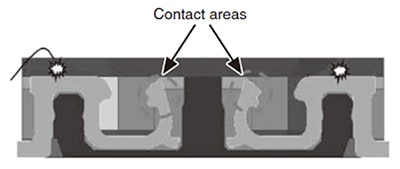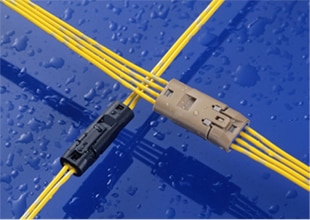Keeping In Contact: Miniature Connectors That Can Take the Strain
投稿人:DigiKey 欧洲编辑
2015-09-01
Sophisticated electronic controls have become the norm throughout sectors such as industry, healthcare, data services, automotive and others. End users expect advanced functionality and colorful, easy-to-understand user interfaces. They also expect extremely high reliability, even though the applicable product regulations do not mandate the use of qualified Hi-Rel parts. Equipment failures may compromise safety or industrial productivity, or may simply spoil the user experience. In any case, the consequences can be serious.
Connectors to rely on
Electrical connectors play a vital role in linking various subsystems like a single-board computer, expansion cards, touch-sensitive display, switches, lights and external data interfaces, and their performance has a direct effect on system reliability. Problems that can occur during assembly, such as bending of contacts, incorrect orientation or incomplete mating, can prevent connectors from maintaining perfect electrical connectivity.
In the field, shocks or vibration can cause momentary loss of contact between pins and receptacles, or may cause individual pins or the entire connector to separate. Connectors mounted on a moving subsystem, such as an inspection or surveillance camera, can be subjected to wrenching forces or repeated stresses that can result in connector failure. There are also environmental challenges such as temperature fluctuations, moisture, dirt or corrosion. Clearly, connectors must be robust enough to withstand these diverse hazards, to guarantee safe transfer of signals and power and so keep the equipment functioning as it should.
However, connector designers are also under constant pressure to achieve smaller footprints and lower profiles, as markets demand greater compactness and portability while at the same time clamoring for more powerful functionality.
Tiny but tough
The challenge is to make connectors that enable designers to satisfy market demands, while incorporating all the features needed to ensure impeccable reliability when exposed to harsh conditions. They also need to be easy to use and assemble, to help prevent errors that can compromise the correct functioning of the equipment. This calls for ingenious design throughout the connector, including the body structure, locking mechanisms, cable guides, pins and receptacles, and the seals of water/splash-proof connectors.
Hirose’s FH28 FPC/FFC-to-board connectors have a standard 0.5 mm contact pitch but are only 2.55 mm high. An integral positioning mechanism works with the FPC/FFC (Flexible Printed Circuit/Flat-Flex Cable) tabs to provide guidance and hold the FPC in the correct location before the locking actuator is engaged. The actuator is supported along its entire length, and a reinforced fitting provides further support and prevents the actuator from disengaging from the connector. The FH28 series is compatible with standard 0.3 mm-thick FPC/FFC, yet provides 2.5 times the vertical retention force and double the horizontal retention force for tabbed FPC/FFC compared with older connector types. The connectors have lower retention forces when used with non-tabbed FPC/FFC.
In addition, the connector underside is enclosed by a fully-molded structure that protects the contacts and allows the designer to position the connector on the board without being constrained by any need to avoid conductive tracks on the surface.
Hirose’s BM10 series 0.4 mm-pitch board-to-board stacking connectors allow an extremely low stack height of 0.6 mm or 0.8 mm, and are only 2.98 mm deep and 10.4 mm long in the case of the 40-position variant. This saves more than 35% of PCB space compared to similar alternatives.
A combination of features ensures very high reliability despite the extreme miniaturization. These include molded guide ribs that allow a wide self-alignment range and ensure smooth mating. Metal corner fittings increase the retention force between the connector and the board and protect the contacts from mechanical stresses. In addition, the insulator bodies incorporate shock-absorbing protrusions and indents that prevent failures when the connectors are exposed to sudden impacts.
The contacts of BM10 connectors also have special design features that enhance electrical and mechanical reliability. These include dual points of contact and extended effective mating length (Figure 1), as well as dimples in the contacts that produce an audible click and provide tactile confirmation of correct assembly. The connectors themselves are fully enclosed to prevent unwanted contamination such as flux spatter. Like the FH28 series, BM10 connectors have no exposed contacts on the underside and therefore give designers freedom to route PCB traces beneath the connector.

Figure 1: Multiple contact points and extended effective contact length in the Hirose BM10 series.
Rugged cable connectors
Circular connectors, which are suitable for cable-to-cable or bulkhead/front-panel mounting, can be configured with versatile combinations of signal and power connections in a number of densities and ratings. Plastic circular connectors provide an economical solution for a wide range of commercial, automotive and industrial applications, and typically incorporate a threaded coupling that ensures reliable retention. The TE Connectivity CPC series has a positive detent that locks the connector halves and so prevents slackening due to shock, vibration or temperature cycling. The CPC locking mechanism also supports quick connect/disconnect capability. The mechanical test procedures for CPC connectors subject mated samples to 12 hours of vibration and repeated shocks, and require the connectors to exhibit no electrical discontinuities of 10 microseconds or longer. Tests for impact resistance and durability of at least 500 mating/unmating cycles are also included.
The CPC connector halves are polarized to ensure correct mating, and feature removable and replaceable parts to simplify repair in the field. Pin and socket protection is built in, and various accessories are available such as cable clamps, boots and sealing caps to assist assembly. Sealing to IP67 is also offered in several configurations. CPC connectors are available in a range of sizes down to 16 mm thread diameter.
Sealed and space-efficient
Some applications, such as automotive wiring, air conditioning systems, vending machines, or lighting systems, demand reliable wire-to-wire connections in extremely confined spaces. These can include small holes or through the centers of hinges. Sealing to prevent ingress of dust and water is often extremely important in these situations. Molex designed its Mizu-P25™ miniature waterproof connectors (Figure 2) to satisfy demands such as these. An inner positive lock integrated as part of the housing saves space and protects the latching area, enabling these connectors to provide some of the smallest mated diameters among any sealed wire-to-wire connector systems on the market. The sizes available range from two or four positions up to seventeen positions, and are as small as 8.2 mm in width.

Figure 2: The low-voltage variants in Molex’s Mizu-P25™ connector system are rated up to 125 V.
Several design features aid fast and accurate assembly, such as low insertion force and a polarizing raised-body design of the male terminal to prevent accidental mismating. The terminals also feature a spring-beam design that ensures high contact pressure and low deflection, which allows Mizu-P25 connectors to be used in applications that are subjected to high levels of vibration. The connectors are IP67 rated, and incorporate space-efficient sealing that utilizes a one-body wire seal to allow close spacing between the terminals. Seal stoppers at the rear of each housing provide waterproof protection and help ensure low mating force. The connectors are able to withstand immersion in up to one meter of water.
Conclusion
Small parts, such as connectors, may warrant less attention from hardware engineers who are keen to get to grips with the latest and most advanced ICs. However, today’s tiny but tough connectors display inspired engineering and precision mechanical design that reward detailed analysis and careful selection. Where appliances are subjected to hazards such as high levels of vibration, water or dust, or where challenging production demands call for fast and faultless assembly, taking the time to identify a suitable high-quality connector can help significantly enhance overall system reliability.

免责声明:各个作者和/或论坛参与者在本网站发表的观点、看法和意见不代表 DigiKey 的观点、看法和意见,也不代表 DigiKey 官方政策。







 中国
中国